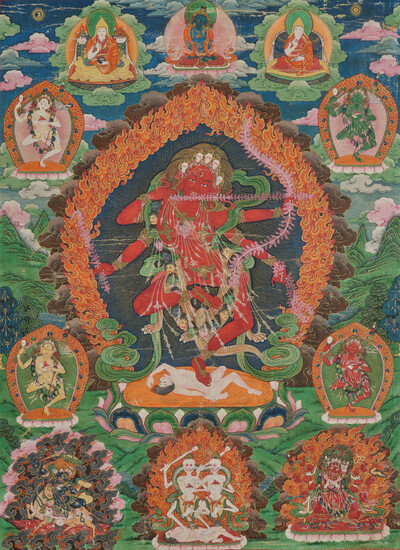TANGKA REPRÉSENTANT KURUKULLA DYNASTIE QING, STYLE DE YONGHEGONG, XVIIIE SIÈCLE
TANGKA REPRÉSENTANT KURUKULLA
DYNASTIE QING, STYLE DE YONGHEGONG, XVIIIE SIÈCLEHimalayan Art Resources item no. 4651 Image: 57 x 42 cm (22 1/2 x 16 1/2 in.)
A THANGKA OF KURUKULLAQING DYNASTY, YONGHEGONG STYLE, 18TH CENTURY清 雍和宮風格 十八世紀 智行佛母唐卡Provenance:With Claude de Marteau, Brussels, by 1970sThe goddess Kurukulla belongs to a set known as the, 'mar chen kor sum' or the Three Great Red Deities, including Takkiraja from the Guhyasamaja Tantra and Maharakta Ganapati from the Chakrasamvara Tantra (see a thangka of Maharakta from the Claude de Marteau Collection, Part 1, sold at Bonhams, Paris, 14 June 2022, lot 57). Dancing atop a pale white corpse, the crimson goddess draws a bow and arrow composed of flowers, symbolic of her power to bewitch the hearts of kings and men through the recitation of her mantras.Floating above the upper recesses of the painting are two monks wearing yellow hats, associating this work with the Gelugpa order and other 18th-century examples from the Yonghegong monastery. Located in Beijing, this lamasery was formerly the monastic residence of Prince Yinzhen prior to his enthronement as the Yongzheng emperor (1723-35) as well as the birthplace of the Qianlong emperor (1736-95). Stylistically, the dense, hilly landscape with earthen-hued clouds bear a striking resemblance to a Chakrasamvara painting in the Yonghegong Collection (HAR 100116) and two other examples published in, Bai Ming (ed.), Beautiful Tangka Paintings in Yonghegong vol.1, 2002, pp. 36 & 81. Also compare a series of paintings commissioned by the Qianlong emperor between 1779 and 1780 for the Xumifushou Temple with similar color schemes to the present lot, published in Singer & Denwood (eds.), Tibetan Art: Towards a Definition of Style, 1997, pp. 110 & 115, nos. 91, 99 & 100.
Sale price
Estimate
Time, Location
Auction House
TANGKA REPRÉSENTANT KURUKULLA
DYNASTIE QING, STYLE DE YONGHEGONG, XVIIIE SIÈCLEHimalayan Art Resources item no. 4651 Image: 57 x 42 cm (22 1/2 x 16 1/2 in.)
A THANGKA OF KURUKULLAQING DYNASTY, YONGHEGONG STYLE, 18TH CENTURY清 雍和宮風格 十八世紀 智行佛母唐卡Provenance:With Claude de Marteau, Brussels, by 1970sThe goddess Kurukulla belongs to a set known as the, 'mar chen kor sum' or the Three Great Red Deities, including Takkiraja from the Guhyasamaja Tantra and Maharakta Ganapati from the Chakrasamvara Tantra (see a thangka of Maharakta from the Claude de Marteau Collection, Part 1, sold at Bonhams, Paris, 14 June 2022, lot 57). Dancing atop a pale white corpse, the crimson goddess draws a bow and arrow composed of flowers, symbolic of her power to bewitch the hearts of kings and men through the recitation of her mantras.Floating above the upper recesses of the painting are two monks wearing yellow hats, associating this work with the Gelugpa order and other 18th-century examples from the Yonghegong monastery. Located in Beijing, this lamasery was formerly the monastic residence of Prince Yinzhen prior to his enthronement as the Yongzheng emperor (1723-35) as well as the birthplace of the Qianlong emperor (1736-95). Stylistically, the dense, hilly landscape with earthen-hued clouds bear a striking resemblance to a Chakrasamvara painting in the Yonghegong Collection (HAR 100116) and two other examples published in, Bai Ming (ed.), Beautiful Tangka Paintings in Yonghegong vol.1, 2002, pp. 36 & 81. Also compare a series of paintings commissioned by the Qianlong emperor between 1779 and 1780 for the Xumifushou Temple with similar color schemes to the present lot, published in Singer & Denwood (eds.), Tibetan Art: Towards a Definition of Style, 1997, pp. 110 & 115, nos. 91, 99 & 100.



